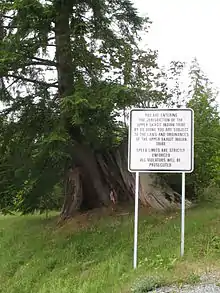Upper Skagit Indian Tribe
The Upper Skagit Indian Tribe is a federally recognized Native American tribe located in the state of Washington. Before European colonization, the tribe occupied lands along the Skagit River, from as far downstream as present-day Mount Vernon, Washington, and villages going north as far as Newhalem along the Skagit River, as well as lands on the Baker, and the Sauk rivers.[1]
| Total population | |
|---|---|
| Enrolled members: 1,336 | |
| Regions with significant populations | |
| Languages | |
| English, Lushootseed dialect (endangered) | |
| Religion | |
| Christianity (incl. syncretistic forms) | |
| Related ethnic groups | |
| Salishan tribes of coastal Northwest, especially Lower Skagit, |
Culturally, the Upper Skagit share characteristics with the Lower Skagit and the Coast Salish, as well as the Plateau Indians on the eastern side of the Cascade Mountains.[2] They traditionally spoke Lushootseed, part of the Salishan language family. It was spoken by many coastal tribes of the Northwest.

Upper Skagit Indian Reservation
The Upper Skagit Indian Reservation consists of three separate small parcels of land in western Skagit County. The largest section, located northeast of Sedro Woolley, is at 48°32′31″N 122°11′15″W, while the smaller western sections are at 48°33′33″N 122°20′42″W (the section where the casino is), and at 48°34′07″N 122°20′43″W, about midway between Seattle and Vancouver, BC on Interstate Highway 5 . The total land area is approximately 100 acres (0.404686 km²). Its resident population was 238 persons as of the 2000 census.[3]
The Tribe owns several successful businesses including The Skagit Casino Resort with the Encore, The Market Buffet and Express Eats restaurants, The Skagit Ridge Hotel, Bow Hill Gas and Food Mart, and the Highway 20 Hometown Pharmacy.
Access to The Skagit Casino Resort is very easy by taking Exit 236 on I-5, from both northbound or southbound lanes, and turning east on Bow Hill Road and going only a few hundred feet before seeing the expansive casino resort. There is plenty of free parking, including numerous disabled parking permit spaces.
See also
Notes
- Collins, June M. Valley of the Spirits: The Upper Skagit Indians of Western Washington. Seattle: University of Washington Press. 1974, p. 17.
- Markowitz, Harvey. American Indians, Salem Press, 1995, p.726.
- "U.S. Census website". Retrieved 2007-04-07.
References
- Bruce G. Miller, “Culture as Cultural Defense: An American Indian Sacred Site in Court,” American Indian Quarterly 22, no. ½ (1998): 83-97, accessed April 13, 2016, Jstor.org
- Deloria, Frank, Lane, Poole, and Al Ziontz, “The Boldt Decision: A Roundtable Discussion,” Journal of Northwest Anthropology 45, no. 1 (2011): 111-122, accessed May 16, 2016
- Janet Yoder, “Burning at Nooksak,” The Massachusetts Review 48, no. 4 (2007): 594-602, accessed May 16, 2016, Jstor.org
- June McCormick Collins, “Indian Shaker Church: A Study of Continuity and Change in Religion,” Southwestern Journal of Anthropology 6, no. 4 (1950): 399-411, accessed April 13, 2016, Jstor.org
- Laurel Sercombe, “Researching the Music of the First People of the Pacific Northwest,” Fontes Artis Musicae 50, no. 2-4 (2002): 81-88, accessed May 16, 2016
- Marian W. Smith, “The Coast Salish of Puget Sound,” American Anthropologist 43, no. 2 (1941): 197-211, accessed May 16, 2016, Jstor.org
External links
- Upper Skagit Indian Tribe, official website
- The Skagit Casino Resort
- Encore
- The Market Buffet
- Express Eats
- Skagit Ridge Hotel
- Upper Skagit Tribe, NW Indian Fisheries Commission
- Upper Skagit Tribe, NW Portland Indian Health Board